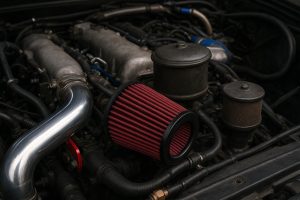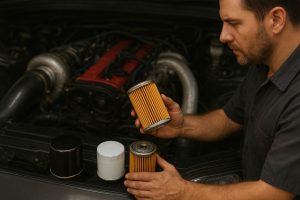If you’ve modified your engine — whether via turbochargers, higher boost, more airflow, or altered fueling — one of the often-overlooked but critical components you must optimize is your filtering system. A filter that’s too restrictive can choke your gains, while one too loose can let contaminants in and damage your investment. In this guide, we’ll walk through the science, trade-offs, and best practices to choose the right air, oil, fuel, and cabin filters for modified engines.
Why Filter Choice Matters More in Modified Engines

A stock engine is often tuned around a factory filter’s airflow and pressure loss characteristics. Once you modify:
-
More airflow demands less filter resistance to avoid creating a “bottleneck”
-
Higher pressures and turbulence increase stress on filter media
-
More aggressive combustion can produce more soot, blow-by, or particulates
-
Higher performance tolerances require cleaner intake air and oil
Thus, your filter selection must scale with your modifications to preserve reliability and harness performance.
Types of Filters You’ll Need to Consider
| Filter Type | Role / What It Protects | Key Performance Parameter(s) |
|---|---|---|
| Intake Air Filter | Prevents dust, sand, particulates from entering the combustion chamber | Airflow (CFM), pressure drop, filtration efficiency |
| Oil Filter | Removes metal particles, soot, debris from engine oil | Filter bypass threshold, micron rating, flow capacity |
| Fuel Filter | Traps contaminants, rust, dirt in fuel line | Micron rating, pressure drop, flow capacity |
| Cabin / Ventilation Filter | Protects occupants and HVAC system | Particle capture, gas adsorption (if activated carbon) |
Intake Air Filter: Balancing Flow vs Filtration
Key Metrics to Consider
-
Airflow capacity (CFM or L/s) at a safe pressure drop (e.g. 0.5 in H₂O)
-
Filtration efficiency / particle retention (how small particles it captures)
-
Media durability under pressure cycling, humidity, heat
-
Cleanability / reusability (washable or replaceable)
Filter Media Types
| Media Type | Pros | Cons / Caveats |
|---|---|---|
| High-flow cotton gauze (oiled) | Good balance of flow and filtration | Requires maintenance (oil, cleaning) |
| Sintered metal / mesh | Durable, washable, high temperature | May lose fine filtration ability at high loads |
| Paper / pleated synthetic | Good for mild modifications | Can be too restrictive at high flow |
| Foam (open-cell) | Very flow-friendly | Often lower filtration for fine dust |
For a modified engine doing 200–300% of stock airflow, a high-flow cotton gauze or sintered media may be preferred.
Oil Filter: Protecting Internal Components
Modified engines tend to generate more wear debris, so the oil filter becomes more critical. When choosing:
-
Micron rating: e.g. 10–20 µm vs 30 µm — finer filtration catches more debris but may restrict flow
-
Bypass valve pressure: A safe bypass in case of clogging; in high-performance setups, bypass thresholds may be tuned
-
Flow capacity / filter area: Ensure the filter can handle higher oil flow rates
-
Material & construction: Reinforced end caps, anti-drainback valves, quality media
During high RPMs and high load, the oil pump must be able to push oil smoothly through your filter; avoid overly restrictive filters.
Fuel Filter: Ensuring Clean Combustion
When pushing more fuel, cleaner fuel becomes more critical. Key filter attributes:
-
Micron rating: Commonly 10–20 µm, sometimes finer on performance fuel systems
-
Flow capacity / pressure drop: Should not starve injectors at peak demand
-
Compatibility: Must resist ethanol, methanol, certain additives, high pressure
-
Replace interval: More frequent changes in motorsport or dusty environments
A restrictive fuel filter can manifest as fuel starvation during high-load or high-RPM acceleration.
Cabin & Ventilation Filter (Optional in Builds)
While not directly impacting engine performance, in many modified or performance cars, occupants and systems still benefit from clean air. An activated carbon or high-grade cabin filter helps block odors, gases, and particulates — especially valuable in urban or racing environments. The activated carbon media traps gases and odors.
Decision Framework & Guidelines
Here’s a checklist to help you select filters for your modified engine:
| Question | What to check / aim for |
|---|---|
| How much airflow increase? | Choose a filter that exceeds expected peak flow by margin |
| Type of environment? (Dusty / Road / Track?) | Use more robust filtration if dusty, consider pre-filters or protective screens |
| Maintenance frequency acceptable? | If you can regularly clean/replace, you can use more aggressive media |
| Oil / fuel system upgrades? | Ensure filters match upgraded pump or injector flow |
| Temperature, pressure, compatibility? | Media should handle the heat, fuel additives, vibration of your build |
| Backup / fail-safe? | Use bypass valves, dual filters, or redundancy in critical systems |
Examples & Comparison Table
| Scenario | Recommended Intake Filter | Oil Filter Suggestion | Fuel Filter Suggestion |
|---|---|---|---|
| Mild bolt-ons (10–30% gain) | High-flow cotton gauze | Performance drop-in filter (10 µm) | OEM spec or mild upgrade |
| Turbo / supercharged build | Large oiled gauze or sintered | Large area, high flow, reinforced filter | 10 µm high-capacity inline |
| Rally / off-road + dusty | Foam pre-filter + gauze | Heavy-duty filter, stronger bypass | Dual-stage filter with sediment trap |
| Drag / full race setup | Open structured media, minimal restriction | High-flow racing oil filter | Ultra-clean filter, frequent changes |
Maintenance & Monitoring

Choosing a good filter is only part of the battle—consistent maintenance is critical:
-
Inspect pressure drop: Use sensors or differential gauges to detect filter clogging
-
Replace or clean early: Never wait until the last possible moment in a performance setup
-
Check housing seals and clamps: Bypass around filters defeats them
-
Use gauge or sensors where possible: oil pressure, fuel pressure drop, air filter DP
-
Keep spares: Especially for track or remote use
Final Thoughts & Call to Action
In a modified engine environment, your filters become part of the performance package, not just a protective afterthought. Choosing filters that match increased airflow, pressure, contaminants, and operating conditions ensures your modifications deliver both power and durability.
When you’re ready to upgrade or replace your filtering solutions, explore available high-performance options and buy Filters online to support your modified engine build.
Drive clean. Stay safe. Build smart.